In search of the perfect fire hose: their evolution over time
The materials used for constructing fire hoses have dramatically changed over the millennia. Ancient Greeks constructed fire hoses using one end of an ox’s intestine attached to a bladder filled with water. When the bladder was pressed, it forced water through the long ox gut and directed it towards burning embers.
A far more recent step in the evolution of fire hoses came in 1673 Amsterdam when inventor Jan van der Heyden and his son sewed lengthy pieces of leather together like a boot leg. These leather hoses were very bulky and tended to burst, however, and they required the application of fish and whale oil to preserve them. Unlined linen hoses soon replaced these leather hoses, and while the early fabric hoses were lighter and didn’t tend to leak, they weren’t very durable.
Since these early efforts, materials for fire hoses have become much more sophisticated: modern fire hoses use a variety of natural and synthetic fabrics and elastomers in their construction. These materials not only offer lighter weight and vastly increased resistance to bursting, they also allow the hoses to be stored wet without rotting significantly and enable them to resist damage from exposure to sunlight and chemicals.
Today, a fire hose is composed of two basic components: a liner to carry the water and a jacket to wrap around the liner, giving the fire hose its strength. In this blog, we explore the materials that make up modern fire liners and the jackets, how they are made, and how their properties and construction make them ideal for their intended purposes.
Fire hose jackets provide strength and protection
Fire hose liners themselves can’t withstand much pressure, so it is the hose’s jacket that has the job of keeping the hose from bursting. Two types of jackets are common for fire hoses: rubber jackets and woven jackets.
Rubber fire hose jackets
As we explained in our guide to choosing a fire hose, rubber hoses evolved as a response to the failures of leather and early fabric hoses. The first rubber hoses had the tendency to balloon up and then burst, however, and although they were more flexible than leather hoses, they did not offer a serious alternative.
But the invention of the vulcanization process transformed raw soft rubber into a harder, more-useful product, giving hope that an easier and more reliable means of transporting a large volume of water onto a fire was possible. It was the B.F. Goodrich Company that fulfilled this promise when it delivered the first rubber first hose to the Cincinnati Fire Department in 1871. The company constructed it by plying alternate layers of heavy square-woven cotton duck and thin rubber over a rubber tube, and then covered the fabric with a final layer of rubber. The practical rubber hose jacket was born.
Today’s rubber-jacketed hoses are often used in applications where additional durability is required but flexibility isn’t key. Rubber jackets tend to resist abrasion better than their fabric counterparts. Many also offer an extra level of resistance to water, chemicals, oils, and other compounds that can damage standard jackets. And while fabric jackets may require thorough washing and drying after use, some rubber-jacketed hoses may only need a wipe-down for cleaning and storage.
Some rubber-jacketed hoses function simply as easy-to-clean, flat-laying attack or supply hoses. But rubber jackets are also often found on the exterior of non-collapsible (rigid) hoses used for water suction, which have a rubber lining, layers of fabric, and, in some cases, a wire mesh for added strength. Pumping water from a pond, lake, or another unpressurized source often requires suction within the hose—a force that causes ordinary hoses to cave in, pinching off the flow of water. By maintaining their shape, rigid hoses allow water to pass through.
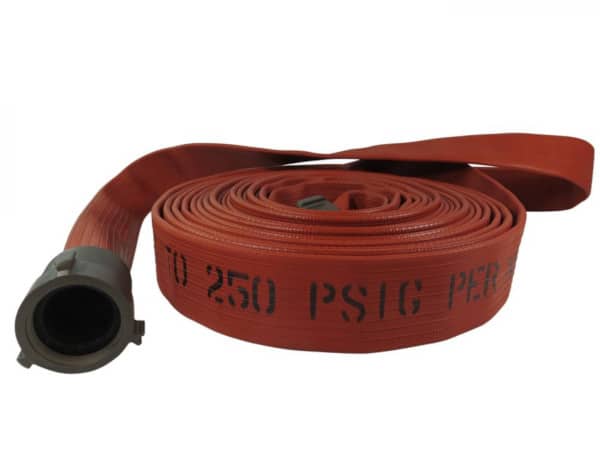
Fabric fire hose jackets
Woven fabric jackets are soft and easy to handle compared to their rubber counterparts; as a result, firefighting professionals turn to them repeatedly for quick deployment. Although cotton was the fabric initially used for woven jackets, they are almost exclusively now made with nylon and polyester yarns, which add strength, flexibility and reduced weight. Nylon is a strong thread, providing abrasion and kink resistance as well as creating a more compact hose. However, a disadvantage is that it often requires abrasion-resistant coatings to protect it from damage and burn-through. Polyester, on the other hand, typically doesn’t need an abrasion-resistant coating, and it is also a bit more durable and cheaper.
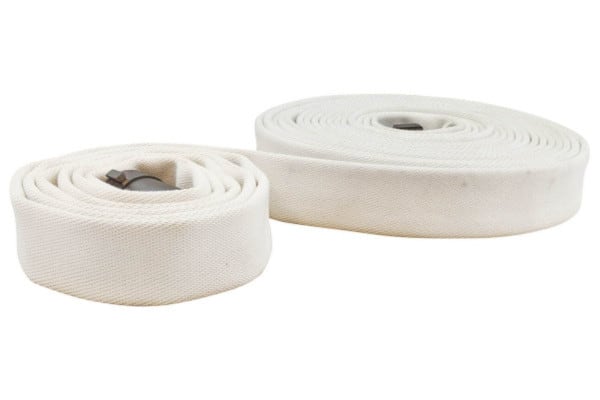
Nylon and polyester yarns are woven, sometimes together, on a circular loom to form a hose jacket. The threads that run lengthwise up and down the hose, forming the inner and outer surfaces of the jacket, provide abrasion resistance. To achieve the strength to resist the internal water pressure, fillers are yarn-wound in a tight spiral around the circumference of the hose. These are made from filament polyester which is gathered together in a bundle of 7-15 fibers and twisted together on a twister frame.
The weave of a fire hose jacket
The weave of the jacket impacts the strength, flexibility, and kink resistance of the hose. All weaves are based on the concepts of warp and weft. Warp yarns or threads run longitudinally down the length of the item being woven, and are first held in place under tension by a loom or frame; weft threads are then sewn crosswise over and under the warp thread.
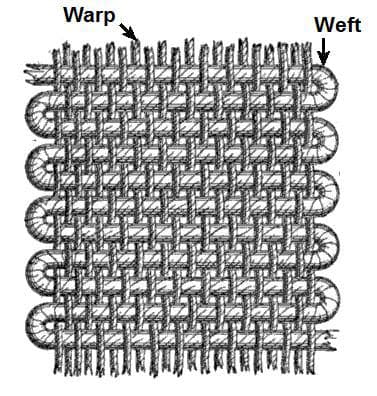
Twill and plain weaves are two common types of weaves used in a variety of applications, including fire hose jackets. Plain weaving is the simplest method, in which warp and weft threads alternate over and under each other at 90 degrees, forming a crisscross pattern.
In twill weaves, a “weft thread is passed over one or more warp threads and then under two or more warp threads and so on, with a ‘step’ or offset between rows to create the characteristic diagonal pattern.” This makes fabrics closer in texture, heavier, and stronger than plain weaves do. The major advantages of twill fabric are that it is durable and wears well, and resists soiling. In addition, the reduced number of interlacings in twill fabric allows the yarns a greater range of motion and freer movement. A reverse twill weave of the inner jacket also promotes a smooth waterway.
Rubber and thermoplastics are the default materials of fire hose linings
Although natural rubber was the only choice possible for many years, several man-made rubbers have become commercially available since the 1940s. Presently, synthetic rubbers are exclusively used to form fire hose linings, although they are sometimes combined with plastics.
Styrene-butadiene rubber, or SBR, was the synthetic rubber commonly used in fire hoses until the early 1990s. Since then, ethylene propylene diene monomer (EPDM) has become the most common lining material and is favored for use in applications where water resistance is critical. Firefighting design professions found that EPDM was easier to manufacture, costs less, and contained several beneficial properties, including chemical resistance and a wider temperature range. EPDM is applied by an adhesive on the hose’s inner jacket.
Thermoplastic liners, a mixture of synthetic rubber and plastics, are also applied by adhesive. These are slightly lighter-weight liners that are less prone to degradation. Their disadvantages are that they are more prone to high friction loss and may be at risk for faster burn-through. In addition, thermoplastic liners do not stretch as easily as EPDM liners, making them more likely to split or shred over time.
Gaining in popularity, extruded liners are manufactured by the application of the liner in a liquid state to the fabric, creating a seal with the inner jacket that is nearly inseparable. An advantage of this construction is that the liner offers a more hydraulically efficient waterway.
Advances in fire hose materials will continue
The trend in fire hose construction has been to create lighter, stronger, and lower maintenance materials. For example, since the development of the circle loom, there has been a push towards higher-tensile and lower-weight-yet-strong yarns with increased flexibility. In addition, scientists are continuing to work on increasing abrasion resistance in synthetic rubber.
But many of today’s fire hoses already offer impressive durability, flexibility, and longevity. Superior Fire Hose, a North Carolina-based manufacturer, makes hoses in a wide variety of diameters, lengths, and couplings with durable jackets and heavy-duty inner liners. With a selection ranging from 125 to 400 PSI, listings from UL and FM, and Superior’s 10-year warranty, these hoses are built for years of reliable service as supply hose, attack hose, suction hose, and more.
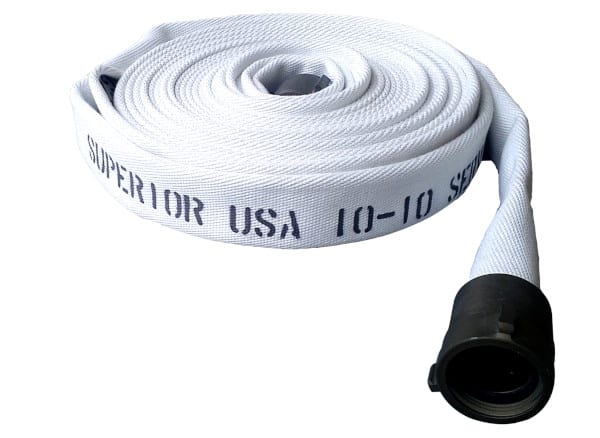
Each Superior fire hose is made-to-order and stamped with the manufacturing date to ease compliance with NFPA standards for replacement. Many hoses are available with Superior’s Steadfast coloring, which increases durability and enhances the visibility of the hose with one of eight colors.
If you have any questions, call us at +1 (888) 361-6662 or email support@qrfs.com.
This blog was originally posted at blog.qrfs.com. If you found this article informative, visit us at Facebook.com/QuickResponseFireSupply or on Twitter @QuickResponseFS.


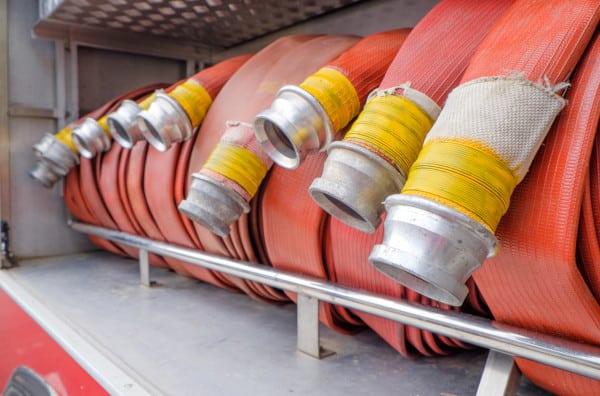
This was a very interesting article. Thank You!
You’re welcome. Thanks for the feedback, Roy, and thanks for reading!